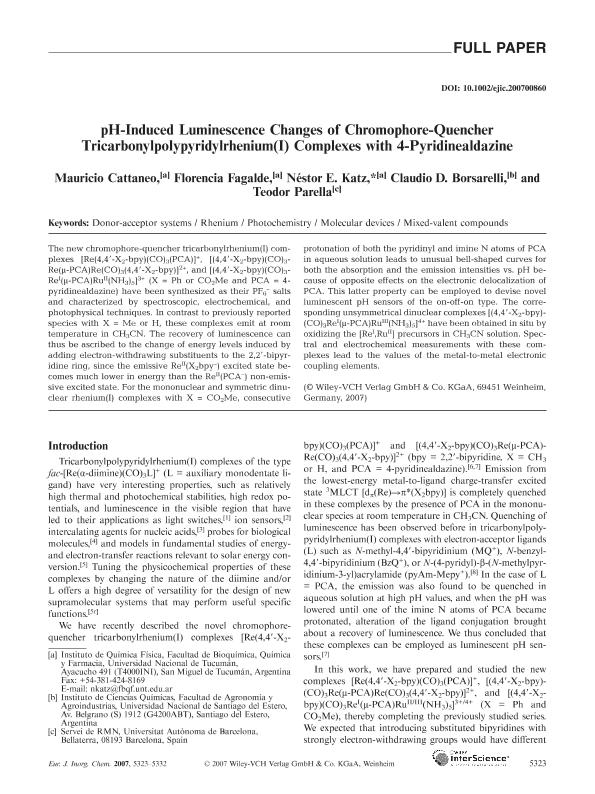Mostrar el registro sencillo del ítem
dc.contributor.author
Cattaneo, Mauricio

dc.contributor.author
Fagalde, Florencia

dc.contributor.author
Katz, Néstor Eduardo

dc.contributor.author
Borsarelli, Claudio Darío

dc.contributor.author
Parella, Teodor
dc.date.available
2019-09-10T20:01:41Z
dc.date.issued
2007-12
dc.identifier.citation
Cattaneo, Mauricio; Fagalde, Florencia; Katz, Néstor Eduardo; Borsarelli, Claudio Darío; Parella, Teodor; pH-induced luminescence changes of chromophore-quencher tricarbonylpolypyridylrhenium(I) complexes with 4-pyridinealdazine; Wiley VCH Verlag; European Journal of Inorganic Chemistry; 34; 12-2007; 5323-5332
dc.identifier.issn
1434-1948
dc.identifier.uri
http://hdl.handle.net/11336/83289
dc.description.abstract
New chromophore-quencher rhenium(I) tricarbonyls, of formulae [Re(4,4’-X2-bpy)(CO)3(PCA)]+, [(4,4’-X2-bpy)(CO)3Re(μ-PCA)Re(CO)3(4,4’-X2-bpy)]2+, and [(4,4’-X2-bpy)(CO)3ReI-(μ-PCA)-RuII(NH3)5]3+, with X = Ph or CO2Me and PCA = 4-pyridinealdazine, have been synthesized as PF6- salts andcharacterized by spectroscopic, electrochemical and photophysical techniques. Contrasting to previously reported species with X = Me or H, these complexes emit at room temperature in CH3CN. The recovery of luminescence can thus be ascribed to the change of energy levels induced by adding electron-withdrawing substituents to the 2,2´-bipyridine ring, since the emissive ReII(X2bpy-) excited state becomes much lower in energy than ReII(PCA-) non-emissive excited state. For the mononuclear and the symmetric dinuclear rhenium(I) complexes with X = CO2Me in aqueous solutions, consecutive protonation of both pyridinic and imine N atoms of PCA cause unusual bell-shaped curves of both the absorption and the emission intensities vs. pH, because of opposite effects on the electronic delocalization of PCA. Therefore, the latter property can be employed to devise novel luminescent sensors of acidity of the on-off-on type. The corresponding unsymmetric dinuclear complexes, of formula [(4,4’-X2-bpy)(CO)3ReI(μ- PCA)RuIII(NH3)5]4+, were obtained in situ by oxidizing the [ReI,RuII] precursors in CH3CN solution; from spectral and electrochemical measurements, the values of the metal-to-metal electronic coupling elements have been determined.
dc.format
application/pdf
dc.language.iso
eng
dc.publisher
Wiley VCH Verlag

dc.rights
info:eu-repo/semantics/openAccess
dc.rights.uri
https://creativecommons.org/licenses/by-nc-sa/2.5/ar/
dc.subject
Donor-Accepto Systems
dc.subject
Rhenium
dc.subject
Photochemistry
dc.subject
Molecular Devices
dc.subject
Mixed Valent Compound
dc.subject.classification
Físico-Química, Ciencia de los Polímeros, Electroquímica

dc.subject.classification
Ciencias Químicas

dc.subject.classification
CIENCIAS NATURALES Y EXACTAS

dc.title
pH-induced luminescence changes of chromophore-quencher tricarbonylpolypyridylrhenium(I) complexes with 4-pyridinealdazine
dc.type
info:eu-repo/semantics/article
dc.type
info:ar-repo/semantics/artículo
dc.type
info:eu-repo/semantics/publishedVersion
dc.date.updated
2019-08-29T17:09:49Z
dc.journal.volume
34
dc.journal.pagination
5323-5332
dc.journal.pais
Alemania

dc.journal.ciudad
Weinheim, Alemania
dc.description.fil
Fil: Cattaneo, Mauricio. Universidad Nacional de Tucumán. Facultad de Bioquímica, Química y Farmacia. Instituto de Química Física; Argentina. Consejo Nacional de Investigaciones Científicas y Técnicas. Centro Científico Tecnológico Conicet - Tucumán. Instituto de Química del Noroeste. Universidad Nacional de Tucumán. Facultad de Bioquímica, Química y Farmacia. Instituto de Química del Noroeste; Argentina
dc.description.fil
Fil: Fagalde, Florencia. Universidad Nacional de Tucumán. Facultad de Bioquímica, Química y Farmacia. Instituto de Química Física; Argentina. Consejo Nacional de Investigaciones Científicas y Técnicas. Centro Científico Tecnológico Conicet - Tucumán. Instituto de Química del Noroeste. Universidad Nacional de Tucumán. Facultad de Bioquímica, Química y Farmacia. Instituto de Química del Noroeste; Argentina
dc.description.fil
Fil: Katz, Néstor Eduardo. Universidad Nacional de Tucumán. Facultad de Bioquímica, Química y Farmacia. Instituto de Química Física; Argentina. Consejo Nacional de Investigaciones Científicas y Técnicas. Centro Científico Tecnológico Conicet - Tucumán. Instituto de Química del Noroeste. Universidad Nacional de Tucumán. Facultad de Bioquímica, Química y Farmacia. Instituto de Química del Noroeste; Argentina
dc.description.fil
Fil: Borsarelli, Claudio Darío. Universidad Nacional de Santiago del Estero. Facultad de Agronomía y Agroindustrias. Instituto de Ciencias Químicas; Argentina. Universidad Nacional de Santiago del Estero. Instituto de Bionanotecnología del Noa. Consejo Nacional de Investigaciones Científicas y Técnicas. Centro Científico Tecnológico Conicet - Tucumán. Instituto de Bionanotecnología del Noa; Argentina
dc.description.fil
Fil: Parella, Teodor. Servei de Rmn; España
dc.journal.title
European Journal of Inorganic Chemistry

dc.relation.alternativeid
info:eu-repo/semantics/altIdentifier/url/https://onlinelibrary.wiley.com/doi/epdf/10.1002/ejic.200790089
dc.relation.alternativeid
info:eu-repo/semantics/altIdentifier/url/https://doi.org/10.1002/ejic.200790089
Archivos asociados
